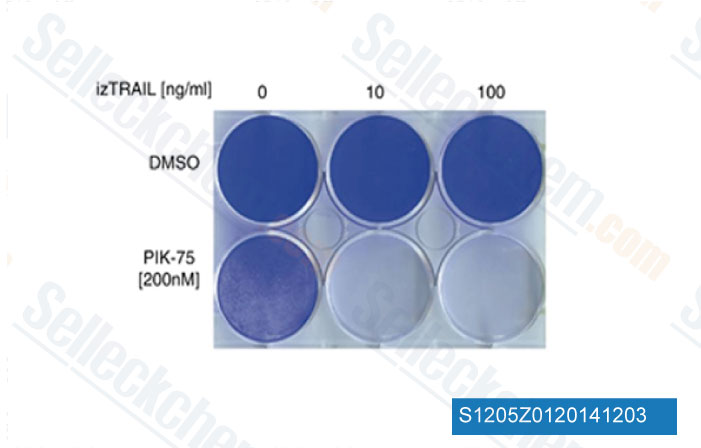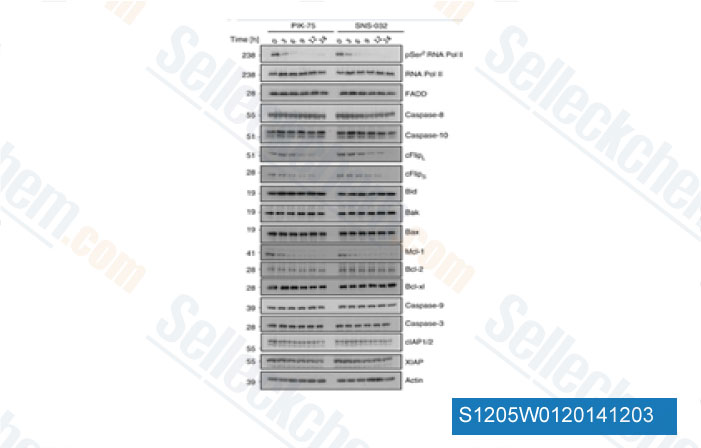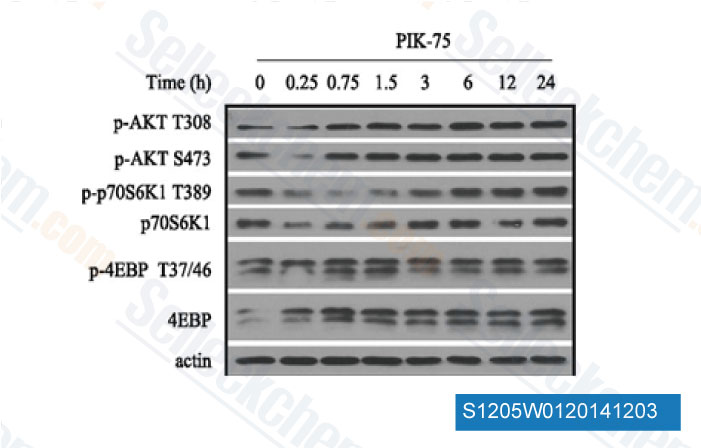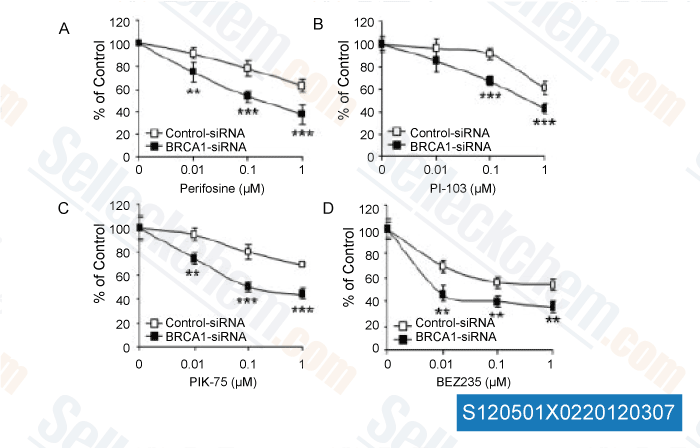|
Toll Free: (877) 796-6397 -- USA and Canada only -- |
Fax: +1-832-582-8590 Orders: +1-832-582-8158 |
Tech Support: +1-832-582-8158 Ext:3 Please provide your Order Number in the email. |
Technical Data
| Formula | C16H14BrN5O4S.HCl |
||||||||||
| Molecular Weight | 488.74 | CAS No. | 372196-77-5 | ||||||||
| Solubility (25°C)* | In vitro | DMSO | 3 mg/mL (6.13 mM) | ||||||||
| Water | Insoluble | ||||||||||
| Ethanol | Insoluble | ||||||||||
| In vivo (Add solvents to the product individually and in order) |
|
||||||||||
|
* <1 mg/ml means slightly soluble or insoluble. * Please note that Selleck tests the solubility of all compounds in-house, and the actual solubility may differ slightly from published values. This is normal and is due to slight batch-to-batch variations. * Room temperature shipping (Stability testing shows this product can be shipped without any cooling measures.) |
|||||||||||
Preparing Stock Solutions
Biological Activity
| Description | PIK-75 HCl is a p110α inhibitor with IC50 of 5.8 nM (200-fold more potently than p110β), isoform-specific mutants at Ser773, and also potently inhibits DNA-PK with IC50 of 2 nM in cell-free assays. | ||||||||
|---|---|---|---|---|---|---|---|---|---|
| Targets |
|
||||||||
| In vitro | PIK-75 shows the impressive potency and isoform selectivity at p110α while the corresponding IC50 values are 1300 nM, 76 nM and 510 nM for other PI3K isoforms, p110β, -γ, and -δ, respectively. Furthermore, when binding to purified p110α, PIK-75 is a noncompetitive inhibitor with respect to ATP with Ki of 36 nM and competitive with respect to the substrate PI with Ki of 2.3 nM. [1] PIK-75 also shows potent inhibition of DNA-PK. [2] PIK-75 (1 μM) reduces cell survival by significantly decreasing mitochondrial activity in unstimulated nonasthmatic airway smooth muscle (ASM) cells, asthmatic ASM cells, and lung fibroblasts. While in TGFβ-stimulated ASM cells, PIK75 only decreases mitochondrial activity in asthmatic cells without effects in nonasthmatic cells. [3] A recent study shows that PIK-75 (10 nM) inhibits TNF-α-induced CD38 mRNA expression and significantly attenuates of TNF-α-induced ADP-ribosyl cyclase activity in human airway smooth muscle cells. [4] | ||||||||
| In vivo | In the ErbB3WT tumor model, PIK-75 reduces in vitro chemotactic response to HRGβ1 and lowers pAkt levels by 40%. Besides, PIK-75 significantly reduces tumor cell motility and in vivo invasion in ErbB3WT primary tumors. [5] In the CD1 male mice, PIK-75 leads to serious impairments in the insulin tolerance test (ITT) and glucose tolerance test (GTT), and an increase in glucose production during a pyruvate tolerance test (PTT). [6] | ||||||||
| Features | PI3K and DNA-PK inhibitor. |
Protocol (from reference)
| Kinase Assay:[1] |
|
|---|---|
| Cell Assay:[3] |
|
| Animal Study:[5] |
|
References
Customer Product Validation

-
Data from [Data independently produced by Cell Death Differ, 2014, 21(3), 491-502]

-
Data from [Data independently produced by Cell Death Differ, 2014, 21(3), 491-502]

-
Data from [Data independently produced by J Pharmacol Exp Ther, 2014, 348(3), 432-41]

-
Data from [Mol Carcinog, 2012, 52, 667-75 ]
Selleck's PIK-75 HCl has been cited by 48 publications
| Lysosomal PIP3 revealed by genetically encoded lipid biosensors [ Proc Natl Acad Sci U S A, 2025, 122(13):e2426929122] | PubMed: 40127277 |
| The mevalonate pathway contributes to breast primary tumorigenesis and lung metastasis [ Mol Oncol, 2024, 10.1002/1878-0261.13716] | PubMed: 39119789 |
| PIK Your Poison: The Effects of Combining PI3K and CDK Inhibitors against Metastatic Cutaneous Squamous Cell Carcinoma In Vitro [ Cancers (Basel), 2024, 16(2)370] | PubMed: 38254859 |
| Pharmacological Targeting of Androgen Receptor Elicits Context-Specific Effects in Estrogen Receptor-Positive Breast Cancer [ Cancer Res, 2023, 83(3):456-470] | PubMed: 36469363 |
| MDM2 antagonists promote CRISPR/Cas9-mediated precise genome editing in sheep primary cells [ Mol Ther Nucleic Acids, 2023, 31:309-323] | PubMed: 36726409 |
| Reciprocal regulation of Daxx and PIK3CA promotes colorectal cancer cell growth [ Cell Mol Life Sci, 2022, 79(7):367] | PubMed: 35718818 |
| The Lectin LecB Induces Patches with Basolateral Characteristics at the Apical Membrane to Promote Pseudomonas aeruginosa Host Cell Invasion [ mBio, 2022, 13(3):e0081922] | PubMed: 35491830 |
| PIK-75 overcomes venetoclax resistance via blocking PI3K-AKT signaling and MCL-1 expression in mantle cell lymphoma [ Am J Cancer Res, 2022, 12(3):1102-1115] | PubMed: 35411248 |
| Identification of New Vulnerabilities in Conjunctival Melanoma Using Image-Based High Content Drug Screening [ Cancers (Basel), 2022, 14(6)1575] | PubMed: 35326726 |
| Isthmin-1 is an adipokine that promotes glucose uptake and improves glucose tolerance and hepatic steatosis [ Cell Metab, 2021, S1550-4131(21)00326-0] | PubMed: 34348115 |
RETURN POLICY
Selleck Chemical’s Unconditional Return Policy ensures a smooth online shopping experience for our customers. If you are in any way unsatisfied with your purchase, you may return any item(s) within 7 days of receiving it. In the event of product quality issues, either protocol related or product related problems, you may return any item(s) within 365 days from the original purchase date. Please follow the instructions below when returning products.
SHIPPING AND STORAGE
Selleck products are transported at room temperature. If you receive the product at room temperature, please rest assured, the Selleck Quality Inspection Department has conducted experiments to verify that the normal temperature placement of one month will not affect the biological activity of powder products. After collecting, please store the product according to the requirements described in the datasheet. Most Selleck products are stable under the recommended conditions.
NOT FOR HUMAN, VETERINARY DIAGNOSTIC OR THERAPEUTIC USE.
